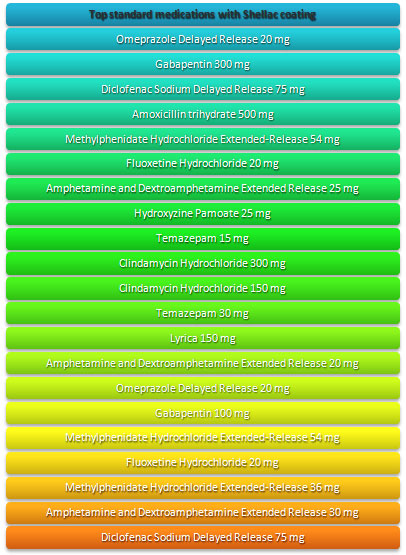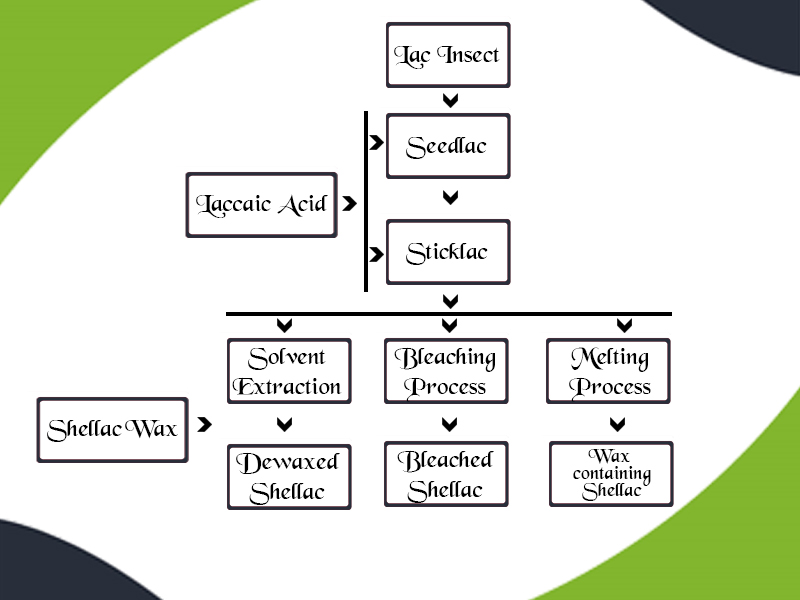Is there enteric coating on your medicinal pills? Find it out
SHELLAC- the name is known by many as an efficient and versatile polymer widely used to coat furnitures, food, fruits, etc. It’s also used as taste masking agent. Pharmaceutical and neutraceutical industries are utilising Shellac since several years for the providence of multiple functional properties.
-
- The reports are as follows:
- National Formulary (NF) has recognized Shellac.
- It is listed in:
- Japanese Pharmacopoeia
- European Pharmacopoeia
- Food Chemicals Codex
- The United States Pharmacopeia
- In European Food Regulations it is noted as E904.
- The United States and Europe has approved Shellac as a food additive.
- FDA has designated Shellac as safe (GRAS).
- The reports are as follows:
Let’ s be familiar with the structural components of Shellac:
Shellac is structurally composed of:
- Esters from polyhydroxyl carboxylic acids
- Polar and non polar components (within the molecule)
- Again, there are 4 main components of carboxylic acid:
- Aleuritic (35%)
- Jalaric (25%)
- Shellolic (8%)
- Butolic (8%)
The enteric coatings contain polymers with the acidic functional groups. The shellac becomes water-soluble in the stomach as the acid groups are protonated in the acidic environment.
- How can Esterification be inhibited?
Ans: Using specific plasticizers
Shellac’s flexibility is improved by the combination of surfactants and plasticisers. Moreover, it raises the film’s adhesive structural reinforcement properties. Specific formulations like Sensient, Protect EN, etc. have been proven effective in the matter of functional reproducibility and product stability over time.
Finally, with the addition of sodium alginate, the entire enteric system of film-coating offers gastric protection along with quality film adhesion and flexibility for the capsules, particles, tablets, etc.
- Coming to the enteric functionality of Shellac:
It is used for producing films with the earmark functionality for meeting the desired dosage release with the digestive tract’s physiological ranges (pH).
- Presenting you a table of an Anatomical pH:

- Comparison between Shellac and HPMC (Hydroxypropyl Methylcellulose):
The comparison between the two is made owing to the character of achieving moisture protection and taste masking.

- It is proved that the resulting drug release in the simulated gastric fluid is not notably changed in character or composition by the thin shellac coatings that quickly ruptured because of the coated tablet core’s swelling.
- Shellac is an acceptable matrix former for the extended-release tablets.
- Shellac is a potential pharmaceutical excipient.
- Let us be knowledgeable with the:

- Median Lethal dose for Shellac:
More than 5 grams per kg (kilogram)
- Is there any probable toxicity resulted from Shellac?
- Studies considering animals show no adverse effects from the dermal, oral, respiratory tract or ocular exposure to the formulations having up to 6% of Shellac.
- Irritation, sensitisation, photosensitisation, mutagenicity is not observed in the clinical analysis of the cosmetic formulations that contain up to 6% of shellac.
Hitherto, according to medical science shellac is okay to consume without any harmful effects as such on our physical and mental health. We can say “Shellac” is the life- time enhancer and taste booster of the pharma world.
The favor of Shellac- Long-Life to the food and other variants
Shellac, the most interesting material that becomes the origin of the long shelf life of many food items, furniture, cosmetics, etc. is a matter of wonder for the people even today. ‘Natural glue’ is the correct term that can be awarded to Shellac.
Whatever you name, whether it’s fruit coating, medicinal pill coverage, a primary ingredient of French nail polish, confectionery glazing agent, printing inks, etc., you will find a familiar and only name that is ‘Shellac.’
We will be enlightened with the various types of shellac and their general usage. But, first, let’s check the refining process of shellac in the form of a chart for better understanding.

Various types of Shellac widely differ in the sphere of material properties. The increase in the differences is clearly understood along with the age of shellac.
- Digging the shellac processibility:
The processibility is influenced by the variations of the mechanical and physiological properties. It decides whether the shellac can be applied in the pharmaceutical industry. Owing to the regulatory status, the material may be allowed for coating the food products where there is no entry of other coating materials. The subcoat compositions lead to the development of the sustained release formulations of drugs and dietary supplements.
- Coming to the shellac variety and their mandatory usage:
- Wax coating shellac:
- It’s origin:
Traditional melting filtration process in which the molten seedlac is pressed via a filter and further spread out to a film
- It’s Usage:
- Shellac is vividly used as a ‘wax coating’ on the citrus fruits to increase the shelf life.
- It replaces the apple’s natural wax that is usually removed during cleaning. It has got a unique food additive E number that is E904.
- Bleached shellac:
- The birthplace:
When the shellac is dissolute in the aqueous alkali solution which is eminently followed by the treatment with sodium hypochlorite, we get bleached shellac. The bleaching process is the source of changes in the molecular structure like chlorination which out-turns in higher reactivity lowering the stability.
- The application of bleached shellac:
- Bleached shellac is non-toxic. Hence it is edible and physiologically harmless.
- The food industry is a lover of bleached shellac. From packaging to overlaying directly on the fruits, sweets, and confectioneries, shellac is the only coating agent, people trust.
- Bleached lac is durable, glossy and odorless. It has adhesive, binding and hardening qualities.
- The plus point is the fast drying character.
- Water – Alkali solutions and transparent or lightly tinted alcoholic solutions can be achieved from bleached lac.
- De-waxed shellac:
- Its contribution to the pharma industry:
- Refined shellac by the solvent extraction is widely used to coat medicinal pills.
- Shellac produced from Laccifer Lacca is utilized for making dentures.
In a nutshell, the benefaction of shellac is implemented as primer, binder, coating, glaze enhancing, adhesive, etc. in cosmetics, food, pharmaceutical products, textiles, adhesives, plastic, rubber, leather, fertilizers, seeds, fruits, wood, pyrotechnics, printer inks, paints, confectionery and many other viable things depending on the character and grade that is best suitable for the specific products.
Evolution of Shellac the Problem Solving Primer
Have you ever wondered how your favorite fruit apple manages to shine and remain tight for an extended period? Or, how does your bitter medicinal pill have glazing outer cover?
The award goes to finest sealing was known as ‘Shellac.’
- Let’s get to the historical background:
If we take a peek into our history-book, we can find the earliest evidence of shellac around 3000 years ago. The shocking wonder comes to our mind when we come to know that Mahabharata depicted that dried shellac is the source material that built an entire palace.
Amazing! Isn’t it?
- A bite on the shellac formation:
Shellac is a resin that is secreted on the trees by the female lac bug. Thailand and India are the chief producers. Production of liquid shellac takes place after it is dissolved in ethanol.
- How does it get sold?
Shellac is first processed and then sold as dry flakes. In the 19th century, Shellac mightily replaced wax and oil finishes. It marked the footprint in the western countries as one of the ruling wood finishes. Then, in the 1920s and 1930s, nitrocellulose lacquer has replaced it.
- Spotlight on the natural progress of shellac usage:
The material was rarely used as dyestuff during the interruption of the East Indies in trade and commerce. The coating stuff was applied in the electrical application due to its excellent insulation qualities and moisture sealing nature. Again, gramophone records (978 rpm) and phonograph were made of shellac. Later, since 1950s long-playing vinyl records started substituting it.
- Unfolding the on-going multiple uses of Shellac:
- Liquid shellac acts as an excellent brush-on colorant, wood finish, and food gloss.
- Shellac is best utilized as a tough natural primer, tannin-blocker, sanding sealant, odor remover, high-gloss varnish, and staining.
- Sealing wax is a meaningful job of shellac.
- It is a mandatory necessity in the pharmaceutical industry due to its edibility. It glazes the confectionary sweets and pills.
- The acidic properties of shellac resist stomach acid. Hence, shellac coated tablets are given to the patients for the enteric or colonic release for some time.
- Shellac is compatible with most of the other finishes.
- The primer coat of wood is often shellac for putting a stop to the bleeding of pigments or resin into the eventual finish.
- It arrests the wood stains from getting blemished.
- Storage life of shellac:
Definitely long
Due to its prolonged shelf life, it is widely put into service as a ‘wax coating’ on the citrus fruits. The natural wax of the apple is replaced by it.
Don’t worry; you don’t have to consume it always as the cleaning of the fruits will remove the overlaying.
- The food additive E number of Shellac:
It’s E904.
Next time you treat your taste buds with the fresh glossy sweets and fruits or furnish your rooms with the polished and stainless vintage furniture, don’t forget the mighty benefaction of the super topping of shellac- the wonder coat.




